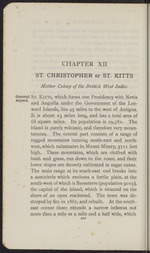| 1 |
 |
“...afternoon’s drive. The reservoirs, which are
scrupulously clean and are surrounded by bright-
coloured crotons and oleanders and ferns, are
by no means unpicturesque. The Blue Basin The Blue
at Diego Martin is 9 miles from Port of Spain;
three hours by carriage there and back. The
beginning of the drive is through the interesting
East Indian village of Peru, and thence up the
Diego Martin valley. At one part the valley
opens out into a flat plain, which formerly used
to be under sugar canes, but is now for the most
part quite uncultivated. The plain has an evil
reputation, having been the scene of no less
than four blood-curdling murders, the last being
when a priest was brutally murdered and was
found tied to a tree. At the head of the valley
conveyances stop, and visitors proceed afoot up
a winding mountain path for about half a mile.
The Blue Basin is a small lake, forty or fifty yards
in diameter, into which a waterfall precipitates
itself in a slanting direction from the midst of
dense...”
|
|
| 2 |
 |
“...moun-
tainous. The scenery throughout the island is
truly magnificent. The main range of mountains,
of an average height of 1500 feet, runs north and
south nearly the whole length of the island,
buttressed by numerous ridges branching off from
it gradually sloping down to the sea on either
side, leaving narrow fertile valleys between them.
The flattest parts of the island are at Gros Islet,
at the extreme north-west, and Vieuxfort, at the
south-east, where the backbone ceases, giving
place to a plain. The Canaries Mountain (3140
feet), near the centre of the island, is the highest
point, and the most mountainous part is on the
leeward side of the island, in the neighbourhood
188...”
|
|
| 3 |
 |
“...I2I,347 152,425 i36,I47 142,965 132,973 £111,849 112,508 99,823 110,036 119,716 99,862
The amount of sugar exported in 1904-5 was
11,940 tons. Cotton to the value of ^£1358 was
also exported.
Climate. Antigua is subject to severe droughts, and the
average annual rainfall is as low as 46 inches.
The island has no rivers, and the wells or springs
in the central plain from St. John’s to Willoughby
Bay being brackish, the only water available is
that which is collected in ponds and pools. Wells
in the limestone region on the north-east of this
central plain yield good water, and there are a
few wells lying to the west and south of the plain.
The water supply of St. John’s is good, being
derived from the hills near Wallings, while Wall-
ings Reservoir furnishes a valuable subsidiary
supply for the country districts. In the winter
months the climate is healthy, except in the
neighbourhood of swamps and marshes. The
death rate is 30 per thousand, but this figure cannot...”
|
|
| 4 |
 |
“...has a total area of
68 square miles. Its population is 29,782. The
island is purely volcanic, and therefore very moun-
tainous. The central part consists of a range of
rugged mountains running south-east and north-
west, which culminates in Mount Misery, 3711 feet
high. These mountains, which are clothed with
bush and grass, run down to the coast, and their
lower slopes are densely cultivated in sugar canes.
The main range at its south-east end breaks into
a semicircle which encloses a fertile plain, at the
south-west of which is Basseterre (population 9019),
the capital of the island, which is situated on the
shore of an open roadstead. The town was de-
stroyed by fire in 1867, and rebuilt. At the south-
east corner there extends a narrow isthmus not
more than a mile or a mile and a half wide, which...”
|
|
| 5 |
 |
“...small
mountain a few miles from Basseterre, which re-
Mount pays a visit. An excursion to Mount Misery, the
Mlsery- extinct volcano which dominates St. Kitts, requires
a full day. The descent into the crater can be
made without danger. At the Weir, a short
distance from Basseterre, monkey shooting can
be indulged in.
Manplain of i
Basseterre to the north-east of the island, the first
halt will probably be made at Brighton Sugar
Works (6 miles from Basseterre), on the only
estate in the island where vacuum-pan sugar is
made. Thence the road keeps quite near the ;
coast. At Dieppe Bay is another sugar estate of...”
|
|
